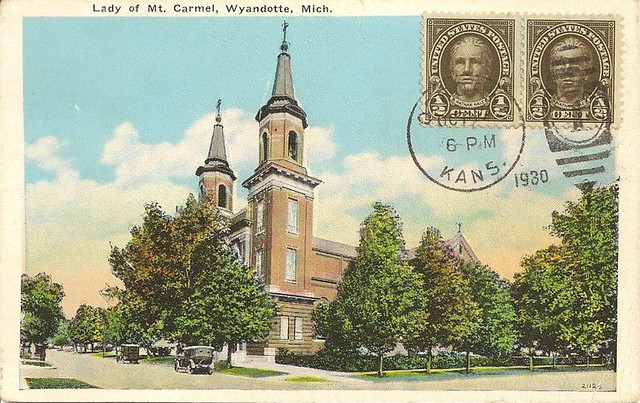 |
| Bishop John Foley |
 |
| Fr. Bernard Zmijewski |
Parishioners wanted the patronage of Our Lady of the Scapular but the request was denied by Bishop Foley. The cornerstone of the combination church and school was laid on December 3, 1899, then completed and dedicated on July 8 of the following year. Rev. Fr. John Moneta, a professor from SS. Cyril and Methodius Seminary in Detroit, preached the homily and was assisted by the choir from St. Josaphat's Church, Detroit.
 |
| Msgr. Adalbert Zadala |
 |
| Fr. Alexander Grudzinski |
Construction of the first church totaled $26,961.15 or more than $700,000 today. This was financed by $7,063.69 in donations, a $15,000 bank loan, and $5,000 from the pastor. Fr. Zmijewski also built a rectory with his own money and started a library filled with 500 volumes of Polish and English books. Fr. Zmijewski petitioned the Felician Sisters to start a school and the request was granted. In September, 1901, they started with two classrooms, for first and second grade, in the basement. the following year, 113 students enrolled.
Disagreements and misunderstanding forced Fr. Zmijewski to be reassigned after six years. His successor, Fr. Frank Sajecki, lasted just one week due to poor health and soon died at the age of 33. Rev. Fr. Joseph Lempka, who was a Vicar at St. Albertus, succeeded as pastor on April 24, 1906, and spent three years dealing with parish debt. in addition to the debt, a new rectory had to be built for $5,000 because the first one was property of the previous pastor.
 |
| Source: Flickr |
The parish quickly went through two more pastors before Rev. Fr. Leon Jarecki came in 1920. He soon added three bells, christened and named them as St. Stanislaus Kostka, Holy Angels, and Queen of Poland. On April 7, 1921, Fr. Jarecki was shot and killed by an unknown murderer when he answered a call at the rectory door.
Rev. Fr. Peter Kruszka soon succeeded as eighth pastor in 22 years and thankfully remained there for 17 years. He established a parish high school in 1928, enlarged the convent and elementary school, and even built a neighborhood heating plant. Failing health forced Fr. Kruszka to go on sabbatical in 1938 however he would not recover and died the following spring.

Enrollment continued to climb over the next decade to a total of 737 elementary students. The parish debt was paid off on January 15, 1946, after nearly fifty years. Fr. Kyrch led renovations of the church and parish grounds until he died from heart disease on March 17, 1956.
Rev. Fr Jerome Juchniewicz took over four years before his death from a heart attack. Rev. Fr. Venanty Szymanski was appointed pastor in September of 1963 and he built a new elementary school building three years later. A financial crisis struck the archdiocese in 1963; six Wyandotte parishes were advised to consolidate to one, central high school and Our Lady of Mt. Carmel refused.
Fr. Szymanski suffered a series of strokes before he resigned in May 1972. Former vicar, Rev. Fr. Stanley Redwick was appointed pastor in August of that year and remained there until poor health forced him to resign in the early 1990s. Rev. Canon Walter J. Ptak succeeded as pastor and remained there until he was reassigned to Ss. Cyril & Methodius Seminary a few years ago.
A Polish sculptor, Czeslaw Dzwigaj, created a statue of St. John Paul II, it was installed outside the southwest corner of the church and blessed by Cardinal Maida on October 31, 2004.
The parish high school closed in 2011 and the elementary consolidated to form St. John Paul II School in Lincoln Park. In 2013, Fr. Mark Borkowski was appointed pastor and the parish merged with St. Stanislaus Kostka (est. 1914). Also in Wyandotte, the former St. Stanislaus Kostka closed shortly afterwards.
Saturdays bring 8:00am Mass, 3:00pm Confessions and 4:30pm Vigil Mass. Sunday Mass is at 6:00am, 8:00am, 10:00am (Polish) and Noon. Daily Mass is at 7:00pm Tu & Th as well as 6:30am M, W, F. First Fridays also bring Adoration 8:30am-10:00am and 5:00pm-6:30pm followed by 7:00pm Polish Mass.
Mt. Carmel Catholic Cemetery, located four blocks northeast of the church, was established in 1865, 34 years before the parish. It has no formal connection to the parish as it is owned and administered by the archdiocese.
Our Lady of the Scapular continues to embrace their Polish heritage with classes focused on making sausage and pierogi, respectively, as well as different art classes and an annual Polish festival in late August.
For more info: parish website & bulletin archive
More photos: flickr
An exhaustive history report: wikipedia
The News Herald articles: parish merger & Fr. Ptak on Pope John Paul II























No comments:
Post a Comment